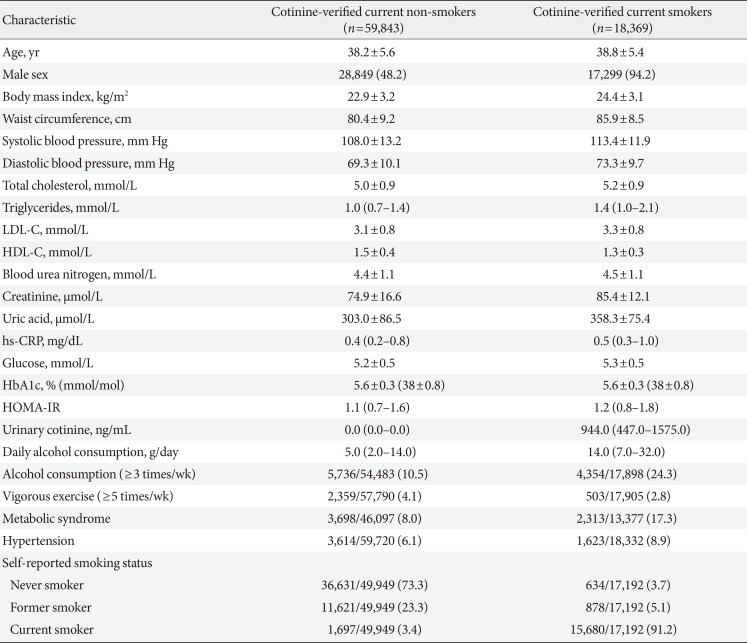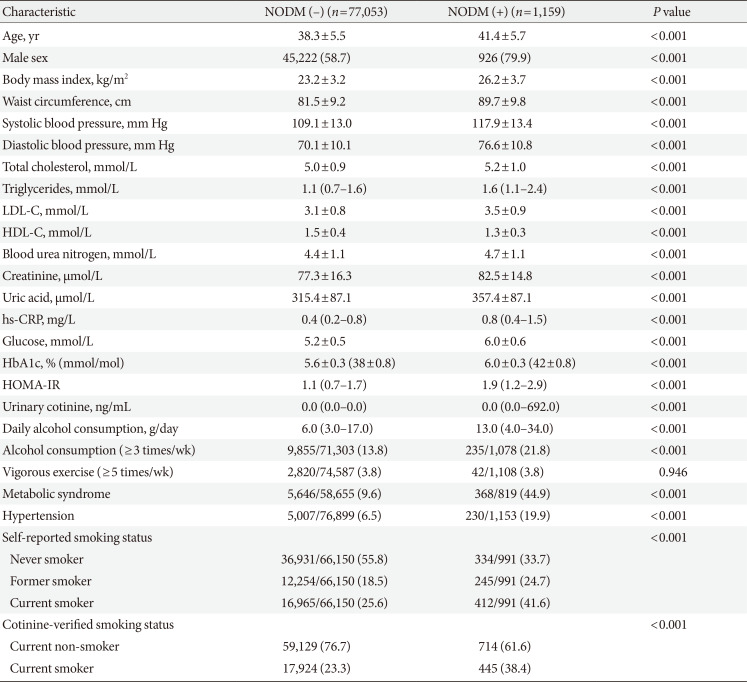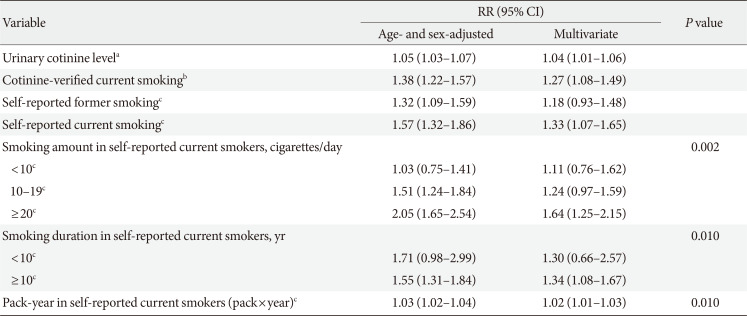1. Shaw JE, Sicree RA, Zimmet PZ. Global estimates of the prevalence of diabetes for 2010 and 2030. Diabetes Res Clin Pract. 2010; 87:4–14. PMID:
19896746.

3. Chang SA. Smoking and type 2 diabetes mellitus. Diabetes Metab J. 2012; 36:399–403. PMID:
23275932.

4. Akter S, Goto A, Mizoue T. Smoking and the risk of type 2 diabetes in Japan: a systematic review and meta-analysis. J Epidemiol. 2017; 27:553–561. PMID:
28716381.

5. Seet RC, Loke WM, Khoo CM, Chew SE, Chong WL, Quek AM, Lim EC, Halliwell B. Acute effects of cigarette smoking on insulin resistance and arterial stiffness in young adults. Atherosclerosis. 2012; 224:195–200. PMID:
22840427.

6. National Center for Chronic Disease Prevention and Health Promotion (US) Office on Smoking and Health. The health consequences of smoking: 50 years of progress. A report of the surgeon general. Atlanta: Centers for Disease Control and Prevention;2014.
7. Eliasson B. Cigarette smoking and diabetes. Prog Cardiovasc Dis. 2003; 45:405–413. PMID:
12704597.

8. Burke AP, Farb A, Malcom GT, Liang YH, Smialek J, Virmani R. Coronary risk factors and plaque morphology in men with coronary disease who died suddenly. N Engl J Med. 1997; 336:1276–1282. PMID:
9113930.

9. Virdis A, Giannarelli C, Neves MF, Taddei S, Ghiadoni L. Cigarette smoking and hypertension. Curr Pharm Des. 2010; 16:2518–2525. PMID:
20550499.

10. Slone D, Shapiro S, Rosenberg L, Kaufman DW, Hartz SC, Rossi AC, Stolley PD, Miettinen OS. Relation of cigarette smoking to myocardial infarction in young women. N Engl J Med. 1978; 298:1273–1276. PMID:
651977.

11. Colditz GA, Bonita R, Stampfer MJ, Willett WC, Rosner B, Speizer FE, Hennekens CH. Cigarette smoking and risk of stroke in middle-aged women. N Engl J Med. 1988; 318:937–941. PMID:
3352685.

12. Pan A, Wang Y, Talaei M, Hu FB. Relation of smoking with total mortality and cardiovascular events among patients with diabetes mellitus: a meta-analysis and systematic review. Circulation. 2015; 132:1795–1804. PMID:
26311724.
13. Kim JH, Kim BJ, Kang JG, Kim BS, Kang JH. Association between cigarette smoking and diabetes mellitus using two different smoking stratifications in 145 040 Korean individuals: self-reported questionnaire and urine cotinine concentrations. J Diabetes. 2019; 11:232–241. PMID:
30091285.

14. Kim JH, Noh J, Choi JW, Park EC. Association of education and smoking status on risk of diabetes mellitus: a population-based nationwide cross-sectional study. Int J Environ Res Public Health. 2017; 14:E655. PMID:
28629199.

15. Foy CG, Bell RA, Farmer DF, Goff DC Jr, Wagenknecht LE. Smoking and incidence of diabetes among U.S. adults: findings from the Insulin Resistance Atherosclerosis Study. Diabetes Care. 2005; 28:2501–2507. PMID:
16186287.

16. Kowall B, Rathmann W, Strassburger K, Heier M, Holle R, Thorand B, Giani G, Peters A, Meisinger C. Association of passive and active smoking with incident type 2 diabetes mellitus in the elderly population: the KORA S4/F4 cohort study. Eur J Epidemiol. 2010; 25:393–402. PMID:
20369275.

17. Connor Gorber S, Schofield-Hurwitz S, Hardt J, Levasseur G, Tremblay M. The accuracy of self-reported smoking: a systematic review of the relationship between self-reported and cotinine-assessed smoking status. Nicotine Tob Res. 2009; 11:12–24. PMID:
19246437.
18. Perez-Stable EJ, Marin G, Marin BV, Benowitz NL. Misclassification of smoking status by self-reported cigarette consumption. Am Rev Respir Dis. 1992; 145:53–57. PMID:
1731599.

19. Parker DR, Lasater TM, Windsor R, Wilkins J, Upegui DI, Heimdal J. The accuracy of self-reported smoking status assessed by cotinine test strips. Nicotine Tob Res. 2002; 4:305–309. PMID:
12215239.

20. Lee A, Gin T, Chui PT, Tan PE, Chiu CH, Tam TP, Samy W. The accuracy of urinary cotinine immunoassay test strip as an add-on test to self-reported smoking before major elective surgery. Nicotine Tob Res. 2013; 15:1690–1695. PMID:
23516325.

21. Jarvis MJ, Tunstall-Pedoe H, Feyerabend C, Vesey C, Saloojee Y. Comparison of tests used to distinguish smokers from nonsmokers. Am J Public Health. 1987; 77:1435–1438. PMID:
3661797.

22. Alshaarawy O, Elbaz HA. Serum cotinine levels and diabetes mellitus in never smokers. J Diabetes Complications. 2015; 29:1032–1036. PMID:
26382617.

23. SRNT Subcommittee on Biochemical Verification. Biochemical verification of tobacco use and cessation. Nicotine Tob Res. 2002; 4:149–159. PMID:
12028847.
24. Kim BJ, Seo DC, Kim BS, Kang JH. Relationship between cotinine-verified smoking status and incidence of hypertension in 74,743 Korean adults. Circ J. 2018; 82:1659–1665. PMID:
29491326.

25. Chiu YL, Huang SJ, Lai CH, Huang CC, Jiang SH, Li SR, Hwang SL, Lin FG, Tzeng YM, Kao S. Validation of self-reported smoking with urinary cotinine levels and influence of second-hand smoke among conscripts. Sci Rep. 2017; 7:15462. PMID:
29133917.

26. Aurrekoetxea JJ, Murcia M, Rebagliato M, Lopez MJ, Castilla AM, Santa-Marina L, Guxens M, Fernandez-Somoano A, Espada M, Lertxundi A, Tardon A, Ballester F. Determinants of self-reported smoking and misclassification during pregnancy, and analysis of optimal cut-off points for urinary cotinine: a cross-sectional study. BMJ Open. 2013; 3:e002034.

27. Ohkuma T, Iwase M, Fujii H, Kaizu S, Ide H, Jodai T, Kikuchi Y, Idewaki Y, Hirakawa Y, Nakamura U, Kitazono T. Dose- and time-dependent association of smoking and its cessation with glycemic control and insulin resistance in male patients with type 2 diabetes mellitus: the Fukuoka Diabetes Registry. PLoS One. 2015; 10:e0122023. PMID:
25822499.

28. Willi C, Bodenmann P, Ghali WA, Faris PD, Cornuz J. Active smoking and the risk of type 2 diabetes: a systematic review and meta-analysis. JAMA. 2007; 298:2654–2664. PMID:
18073361.
29. Zhang L, Curhan GC, Hu FB, Rimm EB, Forman JP. Association between passive and active smoking and incident type 2 diabetes in women. Diabetes Care. 2011; 34:892–897. PMID:
21355099.

30. Wannamethee SG, Shaper AG, Perry IJ. British Regional Heart Study. Smoking as a modifiable risk factor for type 2 diabetes in middle-aged men. Diabetes Care. 2001; 24:1590–1595. PMID:
11522704.

31. Beziaud F, Halimi JM, Lecomte P, Vol S, Tichet J. Cigarette smoking and diabetes mellitus. Diabetes Metab. 2004; 30:161–166. PMID:
15223988.

32. Korea Centers for Disease Control and Prevention. Trend of current smoking rates among Korean adults aged 19 and over, 2007–2016. cited 2019 Sep 29. Available from:
http://www.cdc.go.kr/CDC/main.jsp.
33. Meigs JB, Muller DC, Nathan DM, Blake DR, Andres R. Baltimore Longitudinal Study of Aging. The natural history of progression from normal glucose tolerance to type 2 diabetes in the Baltimore Longitudinal Study of Aging. Diabetes. 2003; 52:1475–1484. PMID:
12765960.

35. Deeb SS, Fajas L, Nemoto M, Pihlajamaki J, Mykkanen L, Kuusisto J, Laakso M, Fujimoto W, Auwerx J. A Pro12Ala substitution in PPARgamma2 associated with decreased receptor activity, lower body mass index and improved insulin sensitivity. Nat Genet. 1998; 20:284–287. PMID:
9806549.
36. Kahn SE, Cooper ME, Del Prato S. Pathophysiology and treatment of type 2 diabetes: perspectives on the past, present, and future. Lancet. 2014; 383:1068–1083. PMID:
24315620.








 PDF
PDF Citation
Citation Print
Print




 XML Download
XML Download